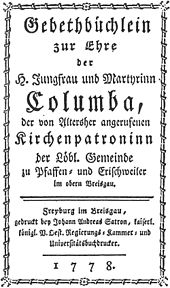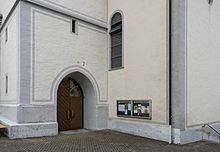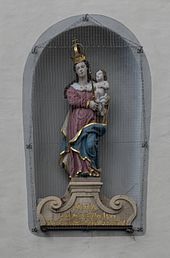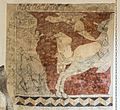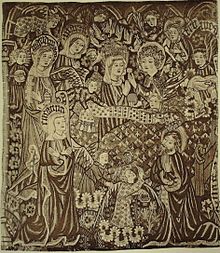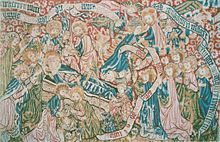St. Columba (Pfaffenweiler)
St. Columba is the Roman Catholic parish church of Pfaffenweiler , a municipality in the Breisgau-Hochschwarzwald district , south of Freiburg im Breisgau in the Schneckental between the Batzenberg in the west and the Schönberg massif in the east. The northern district of Pfaffenweiler, Öhlinsweiler , has a chapel dedicated to Saints Rosalia and Barbara . A chapel dedicated to St. Servatius stands south of the built-up area in the forest. The parish of St. Columba is part of the pastoral care unit Batzenberg-Schönberg of the Archdiocese of Freiburg . The history and shape of St. Columba have been researched in particular by the pastor of the neighboring village of Ebringen , Manfred Hermann , and the Pfaffenweiler archivist Edmund Weeger (* 1942).
history
After an in St. Monastery Gallen in the year 850 made out certificate poured Alemannic nobleman the monastery land in Openwilare , namely "sub Elperico brisk", "under King Chilperic," the Merovingian king Chilperic II. , Between 716 and 720. Openwilare was presumably not today's Pfaffenweiler, but a lost town in the Schneckental. Earlier than Pfaffenweiler Öhlinsweiler is in a document of 1094 the monastery Allerheiligen , Schaffhausen , as Oleswilare safely called. Pfaffenweiler itself, Phaphenwil , follows in 1275.
First lords were the Zähringer , after their extinction in 1218 the Üsenberger , who in turn enfeoffed the Lords of Staufen . They remained feudal bearers even after the overlordship passed to the Habsburgs in the 15th century. So Duke Albrecht VI enfeoffed. - 1457 founder of the University of Freiburg - 1439 Werner von Staufen and his brothers Burkhard and Heinrich with "Pfaffenwyler Olißwiler Bergkhusen vnnd Talhusen <...> vnser vnd the Hüß Osterrich fiefdom from the rulership of Vsenberg ruling". Pfaffenweiler, Öhlinsweiler and the villages of Talhausen and (departed) Berghausen, which today belong to Ehaben, are also mentioned together in other feudal letters. With the Lords of Staufen, Pfaffenweiler remained Catholic during the Reformation . In 1602 the lords of Staufen died out in the male line. In 1628, in the middle of the Thirty Years' War , the Habsburgs pledged the rule of Staufen, including Pfaffenweiler and the neighboring Kirchhofen to the south, to Franz Hannibal von Schauenburg († 1634) . On April 1, 1633 Wallenstein appointed the Schauenburger commander in chief of the imperial troops fighting with the Swedes in the Upper Rhine region and commander of the Breisach fortress . "With this decision, the fate of the subjects from Kirchhofen and Pfaffenweiler came close to the big politics and was unduly linked to that of their local lord."
During the battle for Breisach, Kirchhofen, Pfaffenweiler and the surrounding villages were destroyed by the Swedes under Rhine Count Otto Ludwig von Salm-Kyrburg-Mörchingen on June 18 and 19, 1633 and their inhabitants killed. According to the official report signed by Schauenburg, the Rhine Count continued
"With fiery bullets to the castle and Fleckhen for so long <...>, he bit himself seized the last elapsed Saturday evening, the Capitain Joann Kleinschmidt lying there with his 400 newly recruited servants there captured, but the Baursami assembled in it sambots Wein und Kindt cut down several parts, everything as well as the surrounding dörffer <...> set on fire and after the perpetration of these arson and murderous acts, as far as one can get news after the time, went to Freyburg. "
The same message is carved into the stone of the high altar of St. Mary's Assumption in Kirchhofen:
"300 Baursleiters and Erbermlicher wise dott beaten Daerunder 89 of Pfaffen and Öhllenschweiler were God wölle Inen and we all give a happy resurrection to eternal life amen."
In 1738 the rule of Staufen, again including Pfaffenweiler and Kirchhofen, came to the St. Blasien monastery as a fief . With the secularization of ecclesiastical rule, the entire area fell to the Grand Duchy of Baden in 1806 . 92 subjects from Pfaffenweiler and 107 subjects from Öhlinsweiler certified the oath of allegiance to the Grand Duke in writing. "It is striking that 9 illiterate men could not sign."
The tradition of church history begins in 1275 with the mention of a "Plebanus in Phaphenwil" in the Liber decimationis of the Diocese of Constance . At that time Pfaffenweiler belonged to the dean's office Wasenweiler . The first known owners of the church set were the Alsatian lords of Rappoltstein . In 1430 Maximin I. Smassmann von Rappoltstein and Hoheneck gave the "kyrchen set of the village Pfaffenwiler" to the Lords of Reinach , who sold it in 1485 to the German Order Coming of Freiburg with the consent of the Rappoltsteiners . For a good three centuries, the Pfaffenweiler parish was held almost exclusively by religious. In 1821 she came from the Diocese of Constance to the newly formed Archdiocese of Freiburg.
Patronage
Except in Pfaffenweiler, there is no church in the Archdiocese of Freiburg consecrated to holy Kolumba von Sens . Remnants of the St. Kolumba Church in Cologne, which was almost completely destroyed in the Second World War, are now integrated into the Kolumba Museum , the art museum of the Archdiocese of Cologne . There are many Columbia churches in France, such as Sainte-Colombe in Fessenheim , Sainte-Colombe in Hattstatt and the predecessor church of Jung St. Peter in Strasbourg . Relations with Alsace probably brought the patronage to Pfaffenweiler.
Building history
Components from the 13th to 14th centuries have been preserved in the choir and tower. In 1541 the tower was raised. From 1779, the Teutonic Order Priest Joseph Karl Mayer (1728–1787, pastor in Pfaffenweiler from 1762 until his death) operated an extension. The parish and the tithe, the Teutonic Order, fought for funding for ten years. In 1780, the builder of the Teutonic Order, Franz Anton Bagnato , designed a renovation that was rejected as too expensive. In 1784 the gallery was enlarged in order to be able to set up the organ of the Freiburg Poor Clare Monastery, closed in 1782 , which was sold on in 1807. From 1790 to 1791 the Freiburg builder and plasterer Johann Joseph Meisburger finally carried out the expansion. He changed both the choir and the nave and converted the triumphal arch in between from a pointed to a basket arch .
An expansion was considered again as early as 1840. From 1879 to 1880 the interior was restored and an organ made by EF Walcker & Co. was installed. In 1900 a sacristy was built and the interior was painted in a neo-Gothic style. In 1969 an interior restoration was planned again, but instead decided under Pastor Adalbert Roth (* 1936, Pastor in Pfaffenweiler from 1969 to 1991) to demolish and rebuild part of the ship - measures that were carried out from 1976 to 1978. The sculptor Helmut Lutz from Breisach played a decisive role in the artistic equipment . The church was rededicated on May 13, 1979.
building
Together with the rectory built in 1572, renovated by Johann Baptist Häring in 1757 and extended in 1908, the former chaplaincy from 1626 and the modern parish center, the church is located on the southeast edge of the old village center. In the west and north, the area around the church is supported by a high stone wall. Of the Meisburgers ship, 1790 to 1791, the western façade of about 2 m and the western façade have remained. In the facade, to which a staircase leads, the round-arched portal opens, above it a round-arched niche, around it three round windows and at the top a square with inwardly curved sides. The old retracted choir has been preserved in the east, the originally polygonal end of which was extended and straightened by Meisburger. It has two arched windows on the side, a raised round window in the east wall and a flat ceiling above a hollow . Meisburger's sacristy, which is built around an older chapel, now a confessional chapel, is connected to the north. In the keystone of the ribbed vault of the chapel, an angel carries a banner with the inscription "Glory to God". To the south of the choir, the tower with a gable roof rises on five floors. The lower floors are illuminated through narrow slits. “1541” is carved into the frame of the south-facing window on the ground floor. The top floor, the bell-shaped storey, opens up in pointed arched windows with Gothic tracery and next to it one in the west and two small, narrow arched windows in the east.
Between these relics of the premodern, the architects of the Archbishop's Building Office constructed the new ship as an octagon from 1976 to 1978. Seen from the outside, the difference to Meisburger is not great. The windows are more arched windows, three in the south and two in the north instead of the previous four in the axially parallel walls. A profiled eaves cornice and the gray of the surrounding plinth, the painted pilaster strips and the window frames bind the building together. “The square light funnel through which the nave is also illuminated is sunk into the roof zone in such a way that it is hardly visible from the outside.” The interior of the ship is all the more surprising. It is very bright thanks to the windows of the axially parallel and sloping walls and the pure white paint on the gray exposed aggregate concrete floor . In addition, there is light from above, because the segments of the wood-paneled ceiling “lead up like a funnel to a glass square through which the entire room is evenly illuminated A change in the cut direction of the warm, light brown wooden panels from segment to segment helps structure the room. The western concrete organ loft juts out at an acute angle in the middle. The old communion bench carved by Joseph Dettlinger in 1902 is set into the parapet of this corner .
During the renovation from 1976 to 1978, a pointed arch portal was broken into the east wall of the tower as the new main entrance. It leads to the groin-vaulted , red-painted tower basement, under the south window (the one with the year "1541" outside) "two winged angel figures cast in concrete <...> as a symbol for the church carry the foundation stone with the year 1978." the visitor enters the octagon through a swing glass door. Another arched portal leads from the basement of the tower into the choir, which Meisburger's basket arch separates from the nave. In the north wall of the choir is the door to the confessional chapel, the rectangular cladding made of yellow Pfaffenweiler sand-lime brick with a frame profile and the year "1630" in the lintel , to the left of it an earlier access to the chapel, apparently very deep and low because the floor of the choir At that time it was deeper, to the right of it a sacrament niche , also apparently very deep.
Furnishing
In the east opposite the new entrance is the cross of the cemetery that used to surround the church and was moved in 1834, made of Pfaffenweiler sand-lime stone and inscribed "1684", behind it the tomb of the Teutonic Order pastor Franz Josef Amann († 1799), Franz Anton Xaver Hauser (1739-1819) attributed. Sandstone sculptures of St. Joseph and John the Baptist by Helmut Lutz flank the staircase leading to the west portal . The quarry stone wall here and in the north is crowned by a concrete band with pine-cone-shaped attachments, furthermore, opposite the north-west corner of the church, by a sandstone sculpture of St. Kolumba with her attribute, the bear who protected her, also by Helmut Lutz and richly decorated with the for testicular swellings characteristic of his work.
In the niche above the west portal stands the baroque stone Madonna by an unknown artist, including the chronogram
" M AR I AE D E I PARAE VI RG I N I BAPT I STAE PRAE CV RSOR I SAN C TOQ V E"
"Mary, the Blessed Mother and Virgin, the Baptist, forerunner and saint."
It gives the year M + I + D + I + V + I + I + I + I + C + V + I + C + V = MDCCVVVIIIIIII = 1722.
Inside, on the exposed aggregate concrete of the octagon, the gray-stained wooden chairs stand in three large blocks. Lutz painted the three windows on the south wall and one window on the north wall in grisaille .
Mural
During the renovation from 1976 to 1978, remains of a painting from the period 1420 to 1440 were discovered on the front wall of the ship and in the choir.
- On the front wall of the ship, to the left of the triumphal arch, the Annunciation of the Lord is depicted at the bottom, poorly preserved . Maria, Gabriel and a vase with a lily between them can be seen. To the left, in a black drawing, in good condition, sits a Jewish prophet, his hands on a staff and his head bowed, probably Isaiah , who is pondering the coming of the Messiah ( Isa. 7:14 EU ).
- Above it in three lines the legend of St. Kolumba. Above, the son of the Emperor Aurelian woos her, she raises both hands in a dismissive manner, and he leaves with a threatening gesture. Below that she is in jail, the bear has thrown a man down, and she is talking to a man while the bear looks back and makes off. On the third line, she is held captive by two men and eventually led to martyrdom.
- At the top left of the triumphal arch above a yellowish zigzag ribbon on a white background, only half of it is preserved, St. George on horseback.
- On the north wall of the choir, four apostles are depicted, each with a banner around their head, the only legible one of which designates the apostle as James the Elder . It is the only one in good condition. “In the sense of the ' soft style ', <er> disappears with an expressive head and strong red beard almost behind the abundance of the folds of the robe and the cloak.” Angels kneel above the apostles, each with a banner. Above it, a canopy with pointed gables, crabs and pinnacles completes the picture.
Altars
The discovery of the wall paintings to the left of the triumphal arch prompted the erection of the left side altar together with the right side to the right of the triumphal arch. There they are now symmetrical around the passage to the basement of the tower, on the left the left (Marien Altar), on the right the right (Nepomuk altar). Above the passage hangs a cross with two putti heads at their feet, presumably by Franz Anton Xaver Hauser (1739–1819) - together an impressive group.
The high altar was carved from 1732 to 1733, before the Meisburg expansion, by the Münstertal carpenter Christian Meyer (1898–1753) and the Münstertal sculptor Georg Dold († 1746). The altar stands on a new concrete base. Magnificently - and deliberately - the blue luster color of the columns, the red of the entablature and the gold of the tendrils outshine the gray and brown of the rest of the church. Outside on the entablature between the lower and upper floors are gold-plated vases with little angels' heads and flowers, on the uppermost entablature sit angels with fluttering hair, the one on the left with a sword, the one on the right with a scale in his hand. The paintings are not baroque. The lower one, a Christmas picture, was painted in 1879 by the Swiss Melchior Paul von Deschwanden in the style of the Nazarenes , the upper one, Saint Kolumba, in 1857 by Dominik Weber (1819–1887) from Freiburg .
The side altars from 1737 and 1741, also before the Meisburg extension, were made by Strasbourg carpenters. They too stand on concrete bases today. The two-storey structure and splendor of colors correspond to the main altar. Both of them have a cartouche above the main painting, "accompanied by two rather naive putti who <...> represent simple, almost primitive works", attributed by Hermann the Pfaffenweiler sacristan Johann Michael Fischer († 1761), who was an amateur sculptor . The sculptures of Kolumba on the left and Agatha on the right on the Marien Altar are also by him . The main painting of the Marian altar is a Maria Immaculata by Johann Pfunner , an early work, around 1741. The main painting of the Nepomuk altar is a portrait of St. Johannes Nepomuk , 1857 by Dominik Weber. Johann Baptist Sellinger carved the two dressed angels next to him . The angel on the right holds a finger to his lips for silence, a reminder of Nepomuk's keeping the secret of confession .
Pfaffenweiler Marienteppich
history
For about a century - from 1782 to 1880 - St. Columba had a medieval tapestry . His journey to Pfaffenweiler is not documented, but it can be traced, as the Catholic priest and archivist Joseph Maria Benedikt Clauss and the Viennese art historian Betty Kurth first managed to do .
In one of the four scenes a nun kneels with the slogan “Gnadēdal”. It is about the now disappeared Poor Clare Monastery Gnadental in the Spalenvorstadt of Basel . The carpet was made there in the 15th century. With the Reformation in Basel, the nuns left the monastery. Five of them found refuge in the Poor Clare Monastery in Freiburg in 1529. They brought them to a recording of the Freiburg Poor Clares liturgical treasures with: "Gemelte 5 frauwen have vill god adorns Schenner in unsser gottshauß brocht, even the best vocal books and unssere beautiful haidische füralthärtücher, and other mer." Among the "füralthärtüchern" antependia , was probably the Marienteppich. When the Friborg Poor Clare Monastery was abolished in 1782, it must have reached Pfaffenweiler in addition to the organ (see building history).
Around 1880 - this is where the documented story begins - the chaplain attendant Albin Müller († 1902) found “an ancient, dust-covered tapestry on the church stage there, which apparently had previously served as an antependium. I cleaned it and hung it up on the gallery in order to occasionally ask connoisseurs of art and antiquity about its worth. But it was thrown back onto the church stage by an unknown hand. "Müller's pastor Fidel Hugel (pastor from 1873) sold the piece" in complete misunderstanding of its value <...> for the ridiculous sum of 80 marks to the somewhat dubious Freiburg bookbinder Ludwig Biehler. ”He divided it into two parts and in 1880 sold the larger part to the Prince of Fürstenberg for 500 marks , so that it ended up in the Princely Fürstenberg collections in Donaueschingen . The smaller section is now in the Museum of Applied Arts Cologne . “One may regret the loss for Pfaffenweiler, and the case is a textbook example of how, despite all the ordinances, valuable ecclesiastical property is squandered by incomprehensible clergymen and church servants who are not aware of their responsibility. In any case, it is not an honor for Pfaffenweiler not to have better guarded this treasure, which is important in every respect! "
A reproduction of the Donaueschingen section is shown annually on the Feast of the Assumption on August 15th in St. Columba .
description
On a red background, leaves and small flowers surround four scenes of the death of Mary and her acceptance into heaven , as told in the Legenda aurea .
- On the Cologne section, 95 cm high and 85 cm wide, the apostle Johannes gives communion to Mary, who is sitting upright in bed . Seven doves, symbolizing the seven gifts of the Holy Spirit , float around their crowned heads. Angels bring the shroud, a stole , holy water kettle and aspergillus or make music. An apostle stands at Mary's feet, three holy women stand by her head, named in their halos as “marta”, “maria magd” and “susanna”. The banner on the right edge is cut off.
- On the Donaueschingen section, 100 cm high and 240 cm wide, on the left, John receives the apostles who, according to Mary's request, have gathered at her deathbed. “While John was preaching in Ephesus , it suddenly thundered. A cloud seized the apostle and set him in front of Mary's house. Maria was so happy to see him again that she couldn't help but tear. All the apostles were seized by clouds in the various places where they preached and fell like rain before the house of the Blessed Virgin. ”The banner that goes out from John's head reads:“ Welcome mulsend ir all sin ir brother and ir gentlemen min. ”In this scene the nun kneels with the banner“ Gnadēdal ”.
- Further to the right, the third scene after Clauss shows "the physical resurrection of Mary". “On the third day a light cloud surrounded the grave, a sweet fragrance spread around it and Jesus, surrounded by a host of angels, descended to earth. Then St. Michael came and introduced the soul of Mary to Jesus, and Jesus said: 'Arise, my friend, vessel of life, temple of glory, so that your body, which has not been desecrated by the unclean, may not be injured by the worms of the grave will!' Then the soul returned to the body of Mary, which rose gloriously from the grave. ”At the head of the sarcophagus an apostle carries a flag. At the foot end a little angel brings a female head, according to Clauss the soul of Mary, so that she can reunite with the body. The slogan reads: "You are the buss unburned bi dē de du moses wirt known" - you are the unburned thorn bush , which is like the one that was known through Moses .
- In the fourth scene, on the right on the Donaueschingen section, Mary is received by Jesus in heaven. An angel holds her crown made up of twelve stars. In the banner on the right, Jesus says: “Until welcome maget rein got, user world alone has you.” At the same time, the belt donation is shown. “While these events were taking place in Jerusalem, Thomas was far away. He came only after the third day and did not want to believe the miracle of the bodily reception. His companions had to open the grave for him, then <Marias> belt fell down, and he believed. "Five apostles look up to Mary, on the left Thomas, whose uplifted hands are reaching Mary the belt through an angel. The banner that begins with Maria reads “tomans min belt I han you gesant do bi is you min deffert known”.
organ
The organ goes back to an instrument that was built in 1880 as op 382 by the organ building company EF Walcker & Co. The instrument has been revised and changed several times over the years. In 1960 the gaming table was moved and the layout changed, and a third manual was added in the 1980s. Today the instrument has 25 stops on three manual works and a pedal.
|
|
|
|
|||||||||||||||||||||||||||||||||||||||||||||||||||||||||||||||||||||||||||||||||||||||||||
- Coupling: II / I, I / P
- Playing aids: collective kicks (p, f, tutti)
Others
The celebration altar , ambo and sacrament stele are united on an altar island raised by three steps, works by Lutz. The ambo bears the evangelist symbols of man, lion, bull and eagle. The sacrament stele is designed as a burning bush ( Ex 3.2 EU ), "one of the most convincing modern tabernacle solutions."
Four processional figures are gathered in the choir, on the high altar Johannes Nepomuk, 1737, and Karl Borromäus , 1767. On the consoles on the walls are St. Kolumba on the left and St. Servatius on the right, works by Sellinger from 1763.
In a niche of the confessional chapel there is a holy Sebastian , pierced by arrows, the only preserved Gothic work of art. On one edge to the left of the sacrament stele is a Pietà from 1784 in a concrete frame designed by Lutz. It is also the thirteenth station of the Way of the Cross, which was probably painted by Maria Catharina Antonia von Litschgi († 1787) . Numerous other works created by her for Pfaffenweiler have been lost. This also applies to her two high altar paintings in the Bad Krozingen parish church of St. Alban . They fell victim to a fire in 2002.
The ringing of four bells was made in 1960 in the Friedrich Wilhelm Schilling bell foundry in Heidelberg. The largest bell, “Columba”, comes from the metal of the old Columba bell from 1738. Its inscription read: “DVRCHS FEIR AM ICH FLOSSEN HANS HEINRICH WEITNAVER SEL WITTWE HAS POURED ME IN KLEIN BASSEL . BEFORE THE COMMON PFAFFEN VND EHRENSCHWILLER . IN YEAR ANNO 1738 IS . TGC GREATER EHR GOD IN ACQUISITIONS OF ALL HOLY TRINITY VND DVRCH VORBITT THE HOLY IVNGFRAV VND MARTERIN COLVMBA FROM A EHRSAMMEN GEMEINDT THE BELLS CAST BEEN. "She had to be delivered in 1942, returned from a post-war bells cemetery back, but had to recast due to damages are .
literature
- Joseph Clauß : The Pfaffenweiler Marienteppich of the 15th century at Heiligenberg Castle. In: Freiburger Diözesan-Archiv 49, 1921, pp. 123–177 ( digitized version ).
- Manfred Hermann: Parish Church of St. Columba Pfaffenweiler. Schnell und Steiner publishing house, Munich, Zurich 1983.
- State Monuments Office Baden-Württemberg and District Office Breisgau-Hochschwarzwald: District of Breisgau-Hochschwarzwald. List of cultural monuments. I. The architectural and art monuments of the former Freiburg district. Pfaffenweiler. Freiburg im Breisgau 1974.
- Discover regional studies online Baden-Württemberg: Pfaffenweiler. Digitized. Retrieved March 26, 2015.
- Pastoral care unit Batzenberg-Schönberg: St. Columba Pfaffenweiler. Digitized. Retrieved March 26, 2015.
- State archive administration Baden-Württemberg: Freiburg im Breisgau, urban and rural district, official district description. Volume II, 2. Rombach, Freiburg im Breisgau 1974, pp. 878-896.
- Edmund Weeger: Pfaffenweiler - a local history. Pfaffenweiler 1997, ISBN 3-922675-66-2 .
Web links
References and comments
- ↑ Weeger 1997, p. 93; after Weeger p. 35 1281 Pfaffenwiler .
- ↑ Weeger 1997, p. 49.
- ↑ Weeger 1997, p. 55.
- ↑ Weeger 1997, p. 56.
- ^ Landesdenkmalamt Baden-Württemberg 1974, p. 181.
- ↑ Weeger 1997, p. 83.
- ↑ This is the first mention of Pfaffenweiler, see above.
- ↑ Hermann 1983, p. 3. According to others, the previous church was consecrated to the Irish monk Columban von Luxeuil who did missionary work with the Alemanni ; so Charles Czarnowsky : A tour through the former collegiate church Jung St. Peter zu Strasbourg. Hiller, Strasbourg 1934, p. 3.
- ↑ a b Discover regional studies online Baden-Württemberg: Poor Clare Monastery Freiburg. Digitized. Retrieved on April 3, 2015. Until the 17th century, the monastery was located on today's Eisenbahnstraße at the location of the main post office, then on the corner of Gauchstraße and Merianstraße.
- ↑ Hermann 1983, p. 6.
- ↑ Hermann 1983, p. 11.
- ↑ Hermann 1983, p. 24.
- ^ Landesdenkmalamt Baden-Württemberg 1974, p. 269.
- ↑ Hermann 1983, p. 17.
- ↑ Hermann 1983, p. 21.
- ↑ Hermann 1983, pp. 17-18.
- ↑ WD Grimm: Sandy limestone with few rock fragments: Pfaffenweiler sand-lime stone. In: Short texts on the preservation of monuments at the Fraunhofer Information Center for Space and Building IRB. Digitized. Retrieved April 4, 2015. The stone was formed in the Tertiary of 30 million years and can be seen in many structures and sculptures in the area.
- ↑ Hermann 1983, p. 14.
- ↑ Hermann 1983, pp. 25-26.
- ↑ Hermann 1983, p. 28.
- ↑ Hermann 1983, p. 26.
- ↑ Hermann 1983, p. 27.
- ↑ At the time of Manfred Hermann's church leader, in 1983, Saint Columba, which was erected in the choir today (2015), was still standing in the Nepomuk altar, and the silent angel lacked its iconographic significance.
- ↑ Clauss 1921.
- ^ Betty Kurth: The German tapestries of the Middle Ages. Schroll, Vienna 1926.
- ^ Brigitte Degler-Spengler : The Poor Clare Monastery Gnadental in Basel 1289–1529. Friedrich Reinhardt AG, Basel 1969.
- ↑ Clauß 1921, p. 132
- ↑ a b Clauß 1921, p. 125.
- ↑ Weeger 1997, p. 140.
- ^ Betty Kurth: The German tapestries of the Middle Ages. Schroll, Vienna 1926, Volume 1, p. 213.
- ↑ Clauss 1921, p. 137 according to Legenda aurea.
- ↑ Sic! This and the three following transcriptions according to Ruth 1926, Volume 1, p. 214; Clauss reads differently here and there.
- ↑ Clauß 1921, p. 138 according to Legenda aurea.
- ↑ Weeger 1997, p. 138.
- ↑ Clauß 1921, p. 144 according to Legenda aurea.
- ↑ Information on the organ ( Memento of the original from August 9, 2016 in the Internet Archive ) Info: The archive link was inserted automatically and has not yet been checked. Please check the original and archive link according to the instructions and then remove this notice.
- ↑ Hermann 1983, p. 23.
- ^ Pastoral care unit Bad Krozingen: St. Alban. Digitized. ( Memento of the original from February 21, 2014 in the Internet Archive ) Info: The archive link was inserted automatically and has not yet been checked. Please check the original and archive link according to the instructions and then remove this notice. Retrieved April 1, 2015.
- ↑ Sigrid Thurm: German Bell Atlas . Volume 4 bathing. Deutscher Kunstverlag, Munich, Berlin 1985, ISBN 3-422-00557-9 , p. 243.
Coordinates: 47 ° 56 ′ 11 ″ N , 7 ° 45 ′ 9 ″ E


